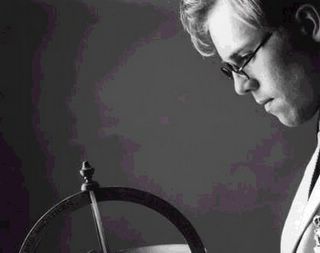
The son of a British archeologist, Thomas Morgan Robertson originally attended college to study meteorology, but he was soon side tracked by electronics, specifically musical equipment, and began building his own synthesizers when he was 18 years old. Around the same time, he began to learn how to play guitar and piano, as well as how to program computers. Eventually, his schoolmates gave him the nickname "Dolby," which was the name for a noise reduction technology for audiotapes. He would eventually take the nickname as a stage name.
In his late teens, Dolby was hired as a touring sound engineer for a variety of post punk bands, including The Fall and The Members. On these dates, he would use a PA system he had built himself.
In 1979, he formed the arty post-punk band Camera Club with Bruce Woolley, Trevor Horn, Geoff Downes and Matthew Seligman. Within a year, he had left the group and joined Lene Lovich's backing band. Dolby gave Lovich his song "New Toy," which became a British hit in 1981. That same year, he released his first solo single, "Urges," on the English independent label Armageddon. By the fall, he had signed with Parlophone and released "Europa and the Pirate Twins."
Dolby started playing synthesizer on sessions for other artists in 1982. That year, he appeared on Foreigner's 4, Def Leppard's Pyromania and Joan Armatrading's Walk Under Ladders. Also in 1982, he wrote and produced "Magic's Wand" for Whodini. The single became one of the first million-selling rap singles. Even with all of these achievements, 1982 was most noteworthy for the release of Dolby's first solo album, The Golden Age of Wireless. "Windpower," the first single from the record, became his first Top 40 UK hit in the late summer.
In January of 1983 Dolby released an EP, Blinded by Science, which included a catchy number called "She Blinded Me with Science." Blinded by Science was a minor hit in England, but the EP and the single became a major American hit in 1983, thanks to MTV's heavy airplay of the "She Blinded Me with Science" video. Eventually, the song reached number five on the US charts and was included on a resequenced and reissued version of The Golden Age of Wireless, which peaked at number 13 in America.
The Flat Earth, Dolby's second album, appeared in early 1984 and was supported by the single "Hyperactive." The single became his biggest UK hit, peaking at number 17. At the same time, Dolby was in demand as a collaborator and he worked with Herbie Hancock, Howard Jones, Stevie Wonder, George Clinton, and Dusty Springfield. During 1985, he produced Clinton's Some of My Best Jokes Are Friends, Prefab Sprout's Steve McQueen (Two Wheels Good in the US), and Joni Mitchell's Dog Eat Dog, as well as supporting David Bowie at Live Aid.
Also in 1985, he began composing film scores, starting with Fever Pitch. In 1986, he composed the scores for Gothic and Howard the Duck, to which he credited himself as Dolby's Cube. That credit led to a lawsuit from the Dolby Labs, who eventually prohibited the musician from using the name "Dolby" in conjunction with any other name than "Thomas."
Aliens Ate My Buick, Dolby's long-delayed third album, appeared in 1988, and the single "Airhead" became a minor British hit.
For the rest of the late '80s and early '90s, Dolby continued to score films, producing, and building his own computer equipment. His fourth album, Astronauts & Heretics, was released in 1992 on his new label, Giant.
The following year, Dolby founded the computer software company Headspace, which released The Virtual String Quartet as its first program. For the rest of the '90s, Headspace occupied most of Dolby's time and energy. In 1994, he released The Gate to the Mind's Eye, a soundtrack to the videotape Mind's Eye. Also that year, Capitol released his greatest hits collection.
While Thomas continued to pursue his own creative endeavors, he was also courted by the developers of synthesizers, audio software and computer games to help them improve the audio capabilities of their products. Noticing that existing audio software was linear, Thomas sought to create software that would make music and sound truly interactive. With the advent of the Web, he found the perfect media for interactive audio.
Beatnik became the embodiment of Thomas' vision. He built the company around a team of musically savvy engineers and technically astute musicians, and secured top management and funding. Today, the same passion and vision that first drew a teenage Thomas Robertson to music and technology, is at the core of Beatnik.
Material quoted directly from: music.yahoo.com & thomasdolby.com
